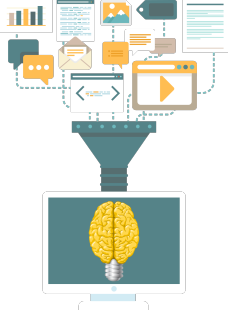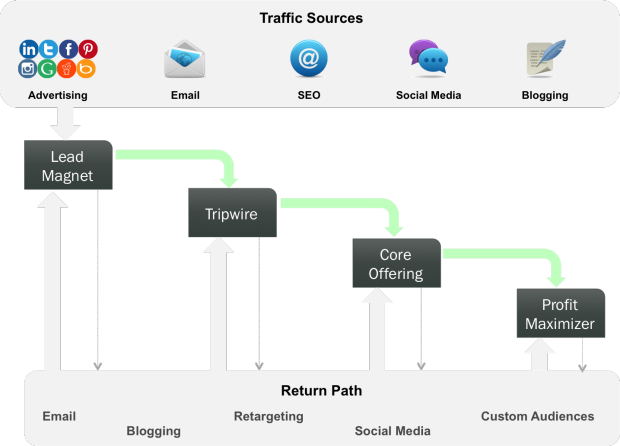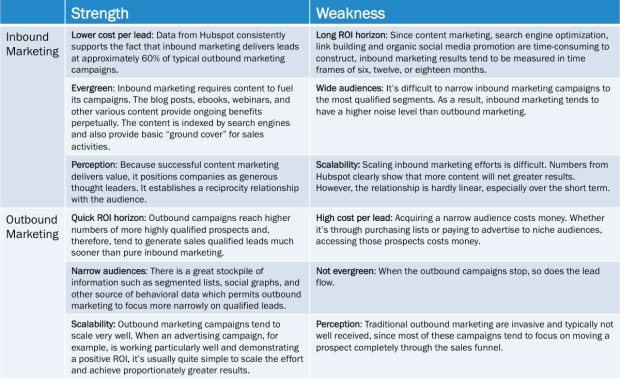 SmartFunnels are simply the next evolution in marketing strategy that take advantage of new technologies and channels. CRM and email marketing system capabilities have advanced to the point where it is relatively simple to create sophisticated digital funnels. And new direct marketing channels have appeared via social media advertising. Together, these give rise to the ability to combine inbound and outbound marketing strategies for optimum results in the shortest possible amount of time.
SmartFunnels are simply the next evolution in marketing strategy that take advantage of new technologies and channels. CRM and email marketing system capabilities have advanced to the point where it is relatively simple to create sophisticated digital funnels. And new direct marketing channels have appeared via social media advertising. Together, these give rise to the ability to combine inbound and outbound marketing strategies for optimum results in the shortest possible amount of time.
Both outbound and inbound marketing have their respective strengths and weaknesses. By combining these approaches, we’ve been able to realize the best of both marketing worlds. Scalable, direct marketing tactics can significantly boost the volume of leads into an inbound marketing funnel, shortening the conversion window while preserving the longer term benefits of content marketing.
Comparing Inbound and Outbound Marketing
 There has been considerable discussion recently regarding inbound marketing and its superiority to outbound marketing. Experience with each approach reveals that each as a share of strengths and weaknesses.
There has been considerable discussion recently regarding inbound marketing and its superiority to outbound marketing. Experience with each approach reveals that each as a share of strengths and weaknesses.
In a sense, it’s a difference without a distinction. It’s all marketing. The goal is to attract prospects and convert them to customers. The strategies and tactics are slightly different, and their respective benefits tend to be perpetuated and exaggerated by businesses and consultants with a product and/or vested interest in one or the other.
(click on the image to view full size)
If you compare the strengths and weaknesses of these two approaches, you’ll notice that they are quite complimentary to one another. Each tends to make up for the shortcomings of the other.
That’s what SmartFunnels are all about. They combine the best of both worlds from traditional outbound marketing and modern inbound marketing in order to deliver the best results in the fastest possible time frame.
What Are SmartFunnels?
SmartFunnels rely on a series of offerings designed to move prospects through the sales funnel, and then on a return path for additional and/or more profitable offers:

- Traffic Sources: It’s fair to say that driving traffic tends to take up the significant share of a digital marketer’s time and resources. Inbound marketing tends to focus on more organic sources, such as search engines and social media. Outbound strategies employ more direct tactics such as advertising and email.
- Lead Magnet: A Lead Magnet is an irresistible “bribe” that delivers value to a prospect in exchange for their contact information. It is likely the first interaction you will have with a prospect and is the entry point into a SmartFunnel. The goal of the Lead Magnet is to convert cold traffic into leads.
- Tripwire: The job of a Lead Magnet is to generate leads. The job of a Tripwire is to convert that lead into a paying customer with an affordable offer. The goal is to create a customer and not necessarily to generate profit at this point.
- Core Offering: Most marketing campaigns attempt to convert cold traffic directly into Core Offer customers. Your Core Offer is the main product or service offered by your business. It’s generally a difficult proposition to make that leap, and depending upon your product or service price point, it can be nearly impossible.
- Profit Maximizer: In some cases, the Core Offer is enough to become profitable and a Profit Maximizer isn’t required. But in other cases, businesses need to increase the average value per customer.
- Return Path: The goal of the Return Path is to have frequent, strategic communication with your buyers and prospects that cause them to buy again and again. This is the final CVO step; increasing the number of transactions per customer.
To learn more about SmartFunnel Campaigns, download our new ebook:

